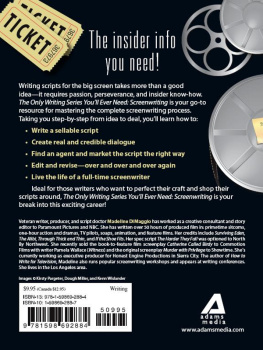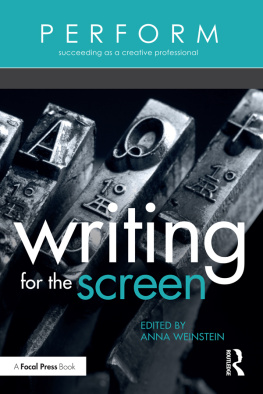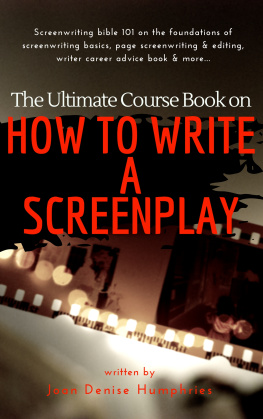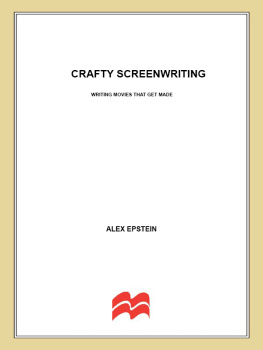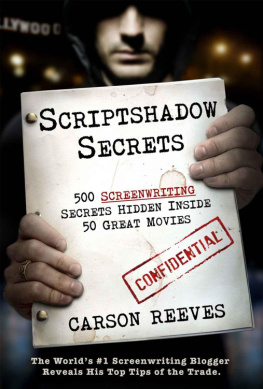
Also by BILL MESCE, JR.
Inside the Rise of HBO: A Personal History of the Company That Transformed Television (McFarland, 2015)
Overkill: The Rise and Fall of Thriller Cinema (McFarland, 2007)
The Rules of Screenwriting and Why You Should Break Them
Bill Mesce, Jr.

McFarland & Company, Inc., Publishers
Jefferson, North Carolina
Box office and budget figures come from
Box Office Mojo: www.boxofficemojo.com.
LIBRARY OF CONGRESS CATALOGUING DATA ARE AVAILABLE
BRITISH LIBRARY CATALOGUING DATA ARE AVAILABLE
e-ISBN: 978-1-4766-2771-7
2017 Bill Mesce, Jr. All rights reserved
No part of this book may be reproduced or transmitted in any form or by any means, electronic or mechanical, including photocopying or recording, or by any information storage and retrieval system, without permission in writing from the publisher.
Front cover image of movie show in cinema and seats 2017 razihusin/iStock
McFarland & Company, Inc., Publishers
Box 611, Jefferson, North Carolina 28640
www.mcfarlandpub.com
To Walter and Ellen, Tom and Renee,
who taught me what I wish Id known at the beginning.
Acknowledgments
First and foremost, I need to thank Dave Beazley and the gang at website Shore Scripts. The seed of this book began with a series of articles for Shore Scripts on the six screenwriting myths, and its safe to say this book would not have happened without that kick-start.
It also goes without saying that I am profoundly grateful to all those talents who contributed their thoughts and insights to this book. They speak from a higher vantage and deeper experience than I, and give this work a weight and breadth I could not have attained on my own.
Among them I have to make a special mention to those who have had a tremendous impact on my work over the years, but on me personally as well, so thank you Pops Persky, and Bernie Dunlap.
Another thanks to my research assistants who have always been there for me on this book as well as past ones: Madeline and Steven DAlessio, Carol and Ron Kochel, and Bill Maass.
And, of course, as always, thanks to my family, whose forbearance warrants canonization.
Movies are like wars.
The guy who becomes an expert
is the guy who doesnt get killed.
Robert Towne,
The Craft of the Screenwriter
Introduction
I may not be recalling all the details quite correctly, but as I remember it, the story goes like this:
The research people at 20th Century Fox advised the studio not to go ahead with a project called The War of the Roses, an adaptation by veteran television writer Michael J. Leeson of a novel by Warren Adler. In the view of Foxs research wizards, the piece was saddled with too many off-putting elements to work commercially. It was a story about an increasingly bitter and nasty divorce, with the two main characters growing ever less sympathetic, even, at one point, killing each others pets (this would later be softened to only appearing to kill each others pets). Worse, it had a downbeat ending with both characters dying. Oh, yeah, I almost forgot; it was supposed to be a comedy.
For whatever reason, Fox chose to go ahead with the project. This 1989 movie that shouldnt be made went on to a domestic gross of $83.7 million, bringing it to #12 for the year in box office. Estimating the number of admissions based on the average ticket price of the time, that would translate into a present-day box office of somewhere between $160170 million; more than 2015s Mad Max: Fury Road, almost as much as The Revenant, and putting it in the top 20 domestic earners of the year.
The point of the story being that trying to analytically approach the process of movie-making to guarantee success (or at least minimize failure) is nothing new. Also not new: nobody knows how to do that; they just think they do. Its like that scene in Moneyball (2011, screenplay by Steven Zaillian and Aaron Sorkin) between Oakland As coach Billy Beane (Brad Pitt) and one of his scouts: You dont have a crystal ball. Ive sat at those kitchen tables with you and listened to you tell those parents, When I know, I know, and when it comes to your son, I know. And you dont. You dont.
A couple of generations ago, the movie industry ran, more or less, on gut instinct. There were no audience research departments. Nor were there film schools, or seminars on filmmaking or screenwriting. Nor was there an Internet to look any of this stuff up.
There was no typical screenwriter in those days. At one time in the early 1930s, the ranks of Movietown screenwriters boasted talent from across the writing spectrum: journalism (like one-time reporters Ben Hecht, Charles MacArthur, Nunnally Johnson, Orson Welles Citizen Kane [1940] co-writer Herman J. Mankiewicz), theater (i.e., George S. Kaufman, Maxwell Anderson, Robert E. Sherwood), and literature (William Faulkner, Dorothy Parker among others) (Kael, 12).
And they forged their screenwriting careers without the benefit of going to a Robert McKee seminar or picking up a book by Syd Field or Blake Snyder. (Illustrative curio: Faulkner worked on To Have and Have Not [1944] when McKee was just three years old. So there!)
As for trying to figure out how to make a good movie good, well, that was as mystifying a process then as it is now.
Consider The Big Sleep (1946). Its long been considered something of a noir classic, although its often also been said the plot doesnt completely make sense. Because it doesnt.
Theres a story Ive heard about the writing of the screenplay. Actually, Ive heard a couple of versions, but the gist is that while William Faulkner and Leigh Brackett were trying to adapt Raymond Chandlers novel (or, depending on the version of the tale you come across, while director Howard Hawks was shooting the movie), the parties involved became aware that Chandler hadnt accounted for one of his storys murders; there was a killing for which there was no killer. Chandler is called/ telegraphed/somehow contacted by the concerned parties, says hes going to re-read the book, then comes back to the production saying something along the lines of, Hell if I know.
Although reviewers at the time shook their heads over a plot which didnt add up, that plot hole never bothered audiences (or, for that matter, the generations of Chandler fans whove read the novel); not the ones who saw it in theaters, and not the later generations of audiences who saw the movie re-run countless times on TV, or in revival houses, oras I didin film classes. Nor has it bothered subsequent generations of critics and film academics who consider it a noir classic.
Why does it work?
Hell if I know. It just does.
The movieslike TV, music, publishing, any of the mass mediahave always wanted to find a way to bottle and reproduce success, even back during the so-called Golden Age of Hollywood. Hey, Humphrey Bogart, Mary Astor, Sidney Greenstreet, directed by John Hustonthey made magic in The Maltese Falcon (1941)! Lets put them all together again in Across the Pacific (1942)! (Huston, 98).
Anybody here remember Across the Pacific? Case closed.
But the motive is understandable; these are expensive endeavors, especially these days. A full 22-episode season of a half-hour network sitcom can cost upwards of $40 to $50 million to produce; a one-hour drama, $120 million or better, and the first-year failure rate for new shows among the four major broadcast nets is somewhere around three out of four (Stelter). The average cost of a studio movie, including marketing, is easily over $100 million (with break-even calculated at two to three times cost), and most studio releases flop at the box office. Yeah, if you were a network programmer, or a television producer, or a studio production exec, with those kinds of stats, if someone said to you, I know how you can make a predictable success, wouldnt you jump at it?
Next page



